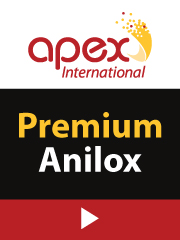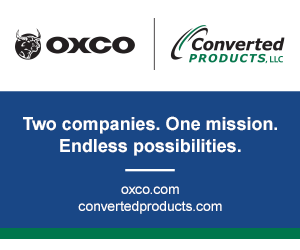Flexible packaging converter treats its customers right.
- Published: November 01, 1996, By Donberg, Deborah
When Flex-Pak purchased a new laminator for snack food packaging, it made sure that bare roll corona treating was included as a means of increasing quality control and minimizing slowdowns.
Flex-Pak Inc., a high quality printer for the snack food industry, has increased its production flexibility and quality control by installing a specially designed Dri-Tec Econolam B series laminator with a bare roll corona treater and 5-kw Compak[TM] 2000 power supply from Enercon Industries Corp.
Flex-Pak is located in a 50,000-sq-ft factory/warehouse in Alpharetta, GA, a northern suburb of Atlanta. Founded in 1979, basically as a poly bag supplier to the textile industry, Flex-Pak today specializes in the cookie, cake, cracker, and salted-snack markets.
"What happened," says general manager James Ramseur, "was that management and ownership changed in 1987. The new team had a strong background in food packaging, and we naturally grew in that direction. Although we still make some poly bags, our primary products are single-web rollstock and laminations. We are basically a food packaging company, but as long as an application is compatible with our equipment, we will print or laminate films for any industry." (Bagmaking equipment is a Ro-An 30-in. Polystar, Model 800, high-speed automatic wicketer.)
As Flex-Pak began to focus on the salted-snack market, it was faced with the serious issue of providing packaging that ensured long-term product freshness. To that end, the company added the Dri-Tec Iaminator to its operations in 1993 to support its increased need for multilayer metallized and printed materials. Bare roll corona treating was included as a means of producing high quality laminated products for the snack packaging industry.
Presses include a five-color Wolverine stack press; two six-color Comexi central-impression presses; and a six-color Kidder CI press. Printing is both line and process. Solvent-based inks are supplied by Croda, Sun Chemical, and Merit. Flex-Pak has a totally enclosed pressroom with an Anguil 10,000-scfm catalytic incinerator that has an overall capture and destruct efficiency of 98.2%.
The company runs all types of substrates, focusing primarily on plain and metallized oriented polyproplyene. Film is from all major suppliers. Slitting is accomplished on equipment from several suppliers, including Dusenbery and Comexi. A fully equipped in-house quality control lab and a fully equipped in-house art department round out the operation.
Overcoming Obstacles
Flex-Pak had to deal with some obstacles associated with laminating. "In lamination technology for snack packaging, you must have good adhesion between the two substrates," according to Ramseur. He explains that to provide a good oxygen and moisture barrier, the inner liner of the bag is metallized, with the metallized substrate helping to preserve the integrity of the snack product. The surface of the printed substrate and the metallized inner film are laminated with adhesive.
However, metallized film presents a problem, because it requires a relatively high dyne level to adhere to the laminate. "When a heavier product such as cookies is specified, a thicker-gauge metallized film is required. This thicker metallized film necessitates a higher dyne level to assure proper adhesion to the outer printed substrate," Ramseur says.
All films shipped to Flex-Pak are tested for proper dyne levels before the production run begins. Some of these films have dyne levels below the manufacturers' specifications due to delays between treatment and shipment. Even when films are received with proper dyne levels, those levels may fall before production can begin.
"When we purchase film for food-service lamination, it comes pretreated with a dyne level between 39 and 42. For various reasons, our client might put a hold on production," Ramseur points out. "The film might lay in storage for three months or longer. During that period of time, the dyne level can drop to 35, which is an unacceptable level of treatment. But when the client is ready to run, we cannot afford to wait."
That is why the Enercon treater was incorporated into the laminator. "We know from past experience how important corona treating is," says Ramseur, "and we knew that somewhere down the line, we would probably have the need for it. Having the treater available allows us to boost the dyne level of the film to an acceptable level exactly when needed. Without the ability to treat internally on the laminator, we would risk substantial production delays."
A Treater That Moves
Flex-Pak does not need the treater in every situation, and sometimes operators have to change which web is being treated. To accommodate this need for flexibility, the Dri-Tec laminator features two monorail treater positions, which allow the treater to he rolled into portion when and where it is needed. The design gives Flex-Pak the versatility to treat at either the primary unwind or the secondary unwind position, and the treater is able to be incorporated into the line without causing a slowing of the line speed.
Ramseur says, "Flex-Pak's strong-competitive advantage is customer service. Corona treating technology together with the advantages of the Dri-Tec laminator help us maintain a strong level of customer satisfaction."
The Next Step
Flex-Pak's next step is to expand its operations both in size and capability by increasing square footage and adding a new eight-color, CI press. The expansion will allow the company to increase the type of packaging it can provide as well as to increase the number of markets it can service. "We are adding new products for meat packaging in addition to the sausage packaging we already produce," says Ramseur. "We hope that our expansion plans will enable us to pursue other meat applications."
Flex-Pak is secure knowing that it has the ability to expand by 10,000-40,000 sq ft. It also owns seven acres that can be added to the expansion, if necessary.
The Dri-Tec laminator with the Enercon corona treater has allowed Flex-Pak to meet the demands of snack food companies by enabling it to provide high quality printed packaging that protects against oxygen and moisture penetration. It has also prepared Flex-Pak for the future by giving it the technology, quality control, and flexibility to meet the continually changing needs of the food-service packaging industry and to expand into new packaging markets.
Supplier Information:
Dri-Tec Inc., Milwaukee, WI; ph: 414/354-3540; fax: 414/354-3541.
Enercon Industries Corp., Menomonee Falls, WI; ph: 414/255-6070; fax: 414/255-7784.
Ro-An Industries Corp., Maspeth, NY; ph: 718/821-1115; fax: 718/821-3838.
Wolverine Flexographic Mfg. Co., Farmington, MI; ph: 810/476-7700; fax: 810/476-0235.
Comexi America Inc., Germantown, WI; ph: 414/255-6644; fax: 414/255-3206.
Kidder Inc., Agawam, MA; ph: 413/786-8692; fax: 413/786-8785.
Croda Inks Corp., Niles, IL; ph: 847/967-7578; fax: 847/967-2232.
Sun Chemical Corp., Fort Lee, NJ; ph: 201/224-4600; fax: 201/224-4392.
Merit Inks & Coatings Co. Inc., Cumming, GA; ph: 770/887-6223; fax: 770/887-6305.
Anguil Environmental Systems Inc., Milwaukee, WI; ph: 414/332-0230; fax: 414/332-4375.
John Dusenbery Co., Randolph, NJ; ph: 201/366-7500; fax: 201/366-7453.













